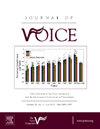Metabolic Roles of Colony-Forming Tissue Stem Cells in the Maculae Flavae of Newborn Vocal Fold In Vivo
IF 2.5
4区 医学
Q1 AUDIOLOGY & SPEECH-LANGUAGE PATHOLOGY
引用次数: 0
Abstract
Objectives
Tissue stem cells in the maculae flavae (a stem cell niche) of the human vocal fold form colonies in vivo like stem cells in vitro. However, the roles of colony-forming aggregated cells in the maculae flavae in vivo have not yet been determined. This study investigated the glycolysis, of the colony-forming aggregated cells in the maculae flavae of the human newborn vocal fold in vivo.
Methods
Three normal newborn vocal folds were investigated under light microscopy with immunohistochemistry and transmission electron microscopy.
Results
Colony-forming aggregated cells in the newborn maculae flavae strongly expressed glucose transporter-1 and glycolytic enzymes (hexokinase II, glyceraldehyde-3-phosphate dehydrogenase and lactate dehydrogenase A). The colony-forming aggregated cells did not express phosphofructokinase-1 (rate-limiting enzyme of regular glucose metabolism pathway) but expressed glucose-6-phosphate dehydrogenase (rate-limiting enzyme) indicating the cells relied more on the pentose phosphate pathway. The colony-forming aggregated cells’ strong expression of lactate dehydrogenase A indicated that they rely more on anaerobic glycolysis in an anaerobic microenvironment. Mitochondrial cristae of the colony-forming aggregated cells in the newborn maculae flavae were sparse. Consequently, the microstructural features of the mitochondria suggested that their metabolic activity and oxidative phosphorylation were low.
Conclusions
The colony-forming aggregated cells in the maculae flavae of the newborn vocal fold seemed to rely more on anaerobic glycolysis using the pentose phosphate pathway for energy supply in vivo. Microstructural features of the mitochondria and the glycolytic enzyme expression of the colony-forming aggregated cells suggested that the oxidative phosphorylation activity was low. Already at birth, in the anaerobic microenvironment of the macular flavae in vivo, there is likely a complex cross-talk regarding metabolism between the colony-forming aggregated cells along the adhesion machinery and chemical signaling pathways which reduces toxic oxygen species and is favorable to maintaining the stemness and undifferentiated states of the tissue stem cells.
新生儿声带黄斑内集落形成组织干细胞的代谢作用
目的:人类声带黄斑(一种干细胞龛)中的组织干细胞在体内会像体外干细胞一样形成集落。然而,黄斑部集落形成的聚集细胞在体内的作用尚未确定。本研究调查了人类新生声带黄斑中集落形成聚集细胞在体内的糖酵解情况:方法:用免疫组织化学和透射电子显微镜对三个正常新生声带进行了研究:结果:新生儿黄斑中的集落聚集细胞强烈表达葡萄糖转运体-1和糖酵解酶(己糖激酶II、甘油醛-3-磷酸脱氢酶和乳酸脱氢酶A)。集落形成的聚集细胞不表达磷酸果糖激酶-1(常规葡萄糖代谢途径的限速酶),但表达葡萄糖-6-磷酸脱氢酶(限速酶),这表明细胞更依赖磷酸戊糖途径。集落形成聚集细胞强烈表达乳酸脱氢酶 A,表明它们在厌氧微环境中更依赖于厌氧糖酵解。新生黄斑中集落形成聚集细胞的线粒体嵴稀疏。因此,线粒体的微观结构特征表明其代谢活性和氧化磷酸化程度较低:结论:新生声带黄斑中的集落聚集细胞在体内似乎更依赖于磷酸戊糖途径的无氧糖酵解供能。线粒体的微观结构特征和集落形成聚集细胞的糖酵解酶表达表明其氧化磷酸化活性较低。在体内黄斑的无氧微环境中,集落形成的聚集细胞之间很可能沿着粘附机制和化学信号通路就新陈代谢进行了复杂的交叉对话,从而减少了有毒氧物种,有利于维持组织干细胞的干性和未分化状态。
本文章由计算机程序翻译,如有差异,请以英文原文为准。
求助全文
约1分钟内获得全文
求助全文
来源期刊

Journal of Voice
医学-耳鼻喉科学
CiteScore
4.00
自引率
13.60%
发文量
395
审稿时长
59 days
期刊介绍:
The Journal of Voice is widely regarded as the world''s premiere journal for voice medicine and research. This peer-reviewed publication is listed in Index Medicus and is indexed by the Institute for Scientific Information. The journal contains articles written by experts throughout the world on all topics in voice sciences, voice medicine and surgery, and speech-language pathologists'' management of voice-related problems. The journal includes clinical articles, clinical research, and laboratory research. Members of the Foundation receive the journal as a benefit of membership.
 求助内容:
求助内容: 应助结果提醒方式:
应助结果提醒方式:


